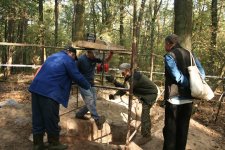Tuberale
Gold Member
Will be making a recovery of a very large meteorite which landed here over 100 years ago. Recovery site is near salt water, so I have to wait for a low tide to make. I'll have to clean overburden. Need to collect a bowling ball sized piece. Any suggestions of how I try doing that? Even if I get several days worth of low tides, hacking the piece I need to ID is problematic. Meteorite is probably a pallasite.





